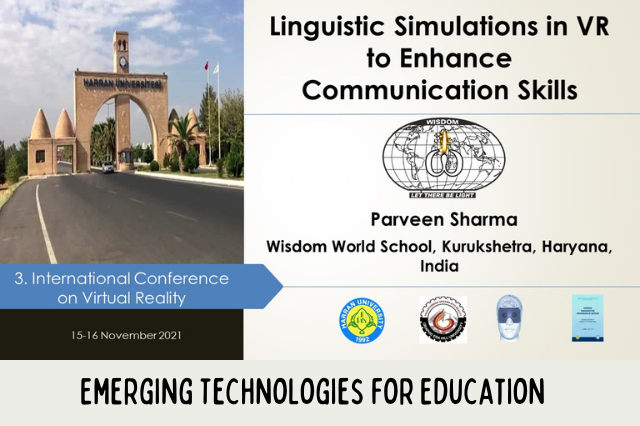An unending urge to expand the horizons of learning and empower my teaching of Communication Skills, this is a proposed integration. The presentation was given during the International Conference on Virtual Reality. The newness of this concept is the applicability and utility it promises. Virtual Reality and Artificial Intelligence can do wonders in the teaching of Communication Skills. Have a look at the presentation and support the idea.
The World we live in is known as VUCA World:
- Volatile
- Uncertain
- Complex
- Ambiguous
We all know these challenging features and at the same time are fighting hard to bring sense to the classroom. In this expedition of adding innovation and creativity, we have found that being an enterprising learner is the key for a teacher. We communicate and intend to accomplish the desired effect. When it fails, we have things to correct and when we succeed, we try to replicate the model. In this presentation, we are proposing the development of Linguistic Simulation to Enhance the Communication Skills of learners of all languages. Primarily, these simulations will be used for the learners who are learning a Second Language (SL) or a foreign language. The cases and observations of the presenter are based on Communication Skills in English. As Indian learners have been learning English as a second language, such a tool and technology will be greatly helpful.
Opportunities that VR can Leverage in Linguistic Simulation
- English as Foreign Language for ‘MOST OF THE WORLD’
- VR can present cultural nuances of language use.
- In the present-day world > an excellent supplement to textbook-learning
- Retention amount and levels improve significantly
- Promising in the future, it could very well change the way in which we teach, learn, and use language.
Tell me, I forget.
Show me, I remember.
Involve me, I understand.
Simulation – Virtual Reality for Communication Skills
- Ease of Learning
- At par with the Trending and in-demand technologies
- It Brings Engagement and learning-centred assessments
- Expands the classroom beyond the walls and ‘WORLDS’
Virtual Reality, Simulations and Augmented Reality
BENEFITS
– increases students’ autonomy and motivation; removes the Linear Model
– lowers their anxiety levels
– develops team-building skills (life skills)
– strengthens cooperation and collaborative skills
– allows students to experiment with new vocabulary and structures
– gives students the freedom to make their own choices and decisions
– helps students to identify and understand different cultures and languages
– gives the students “I’ve done it, so I can do it” confidence
– dismantles the teacher-dominated learning/instruction
Virtual Reality, Simulations and Augmented Reality
Drawbacks
– can reinforce faulty pronunciation, vocabulary and grammar
– might leave teachers feeling ineffective or excluded
– allows students to misunderstand and misuse new vocabulary and structures
–already effective speakers take advantage
– requires preparation
– requires more time for the implementation (planning, preparatory stage, the adaption of the classroom, materials with “facts” etc.)
– might allow less motivated students to withdraw from participation
Virtual Reality, Simulations and Augmented Reality
Solutions
– ensure that the Simulation is of relevance and interest to the students
– base subsequent remedial work on observations taken during monitoring
– plan new simulations considering the interests of students and their feedback
– integrate Communication Skills, language learning simulations with other subjects
– design the content for beginners in the medium of the target language
– choose a simple topic familiar to most students, even as beginners
– construct groups containing mixed or differentiated levels of ability depending on
their students’ needs
– monitor the groups’ language and participation levels and take notes for constructive feedback
Watch the Video of the Live Presentation HERE on the channel of the International Conference on Virtual Reality
The slides are shared HERE







